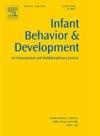调查年龄和自主运动对第一年婴儿位置使用的影响
IF 2
3区 心理学
Q3 PSYCHOLOGY, DEVELOPMENTAL
引用次数: 0
摘要
本研究探讨了年龄和自主运动对一岁婴儿使用物理空间的影响。共有18名健康婴儿(8名男婴,10名女婴)从平均起始年龄2.77个月到12个月在家中进行了纵向观察。每个月,自然主义的视频记录下每个婴儿大约30 分钟不间断的自发玩耍,研究人员作为被动的观察者。连续编码量化了婴儿使用不同位置(如地板、婴儿床、看护人)的频率和持续时间。结果显示,婴儿在不同家庭中经历了可比性的负担,证实了真正的行为差异,而不是差异。地点频率不随年龄变化,但会爬的婴儿比会爬的婴儿访问更多的地点。限制位置的时间随着年龄的增长而减少,而地板时间增加,特别是在爬行开始之前。最终,发育变化的特征是在限制性位置的时间减少,在地板上的时间增加,探索的总频率与运动状态的关系比实足年龄更密切。本文章由计算机程序翻译,如有差异,请以英文原文为准。
Investigating the effects of age and autonomous locomotion on infant location use during the first year
This study investigated the influence of age and autonomous locomotion on infants’ use of physical spaces during the first year of life. A total of 18 healthy infants (8 male, 10 female) were observed longitudinally in their homes from an average starting age of 2.77 months through 12 months. Monthly, naturalistic video recordings captured approximately 30 min of uninterrupted spontaneous play per infant, with the researcher acting as a passive observer. Continuous coding quantified the frequency and duration of infants’ use of distinct locations (e.g., floor, crib, caregiver). Results revealed that infants experienced comparable affordances across households, validating true behavioral variation rather than differential access. Location frequency did not vary with age, but crawling infants visited more locations than pre-crawlers. Time in restrictive locations decreased with age, while floor time increased, particularly before crawling onset. Ultimately, developmental changes were characterized by reduced time in restrictive locations and greater time on the floor, with total frequency of explorations more closely tied to locomotor status than chronological age.
求助全文
通过发布文献求助,成功后即可免费获取论文全文。
去求助
来源期刊

Infant Behavior & Development
PSYCHOLOGY, DEVELOPMENTAL-
CiteScore
4.10
自引率
4.80%
发文量
94
期刊介绍:
Infant Behavior & Development publishes empirical (fundamental and clinical), theoretical, methodological and review papers. Brief reports dealing with behavioral development during infancy (up to 3 years) will also be considered. Papers of an inter- and multidisciplinary nature, for example neuroscience, non-linear dynamics and modelling approaches, are particularly encouraged. Areas covered by the journal include cognitive development, emotional development, perception, perception-action coupling, motor development and socialisation.
 求助内容:
求助内容: 应助结果提醒方式:
应助结果提醒方式:


